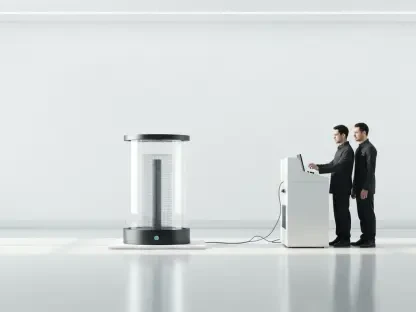Imagine walking into a store or browsing online to purchase a vacuum cleaner, only to be confronted with a dizzying array of names like V16 Piston Animal, Gen5detect, and V15 Detect, leaving many consumers puzzled. For countless buyers, this is the reality when exploring Dyson’s innovative lineup of vacuum cleaners, a brand celebrated for its engineering prowess but often criticized for a naming system that seems more cryptic than clarifying. This review dives into the technology behind Dyson’s product nomenclature, dissecting its structure, intent, and impact on the user experience. By examining how these names reflect cutting-edge features while simultaneously creating barriers, this analysis aims to shed light on a branding strategy that is as intriguing as it is perplexing.
Decoding the Naming Architecture
The “V” Series and Numerical Patterns
At the core of Dyson’s vacuum naming lies the “V” series, a structure that initially promised a logical progression with models like V8, V10, and V15 suggesting newer iterations as numbers increased. This system, while intuitive at first glance, quickly reveals inconsistencies with gaps in the sequence—such as the absence of V13 or V14—potentially tied to cultural aversions to certain numbers. These omissions disrupt the expectation of a straightforward timeline, leaving consumers to question the significance of each jump in numbering.
Moreover, the numerical approach does not always align with release order or technological advancement. Some increments appear to signify major upgrades, while others feel arbitrary, lacking clear communication of what distinguishes one model from the next. This irregularity often forces potential buyers to delve into detailed specifications rather than relying on the name as a quick guide, undermining the branding’s effectiveness as a tool for instant recognition.
Technology as a Naming Cornerstone
Dyson frequently embeds specific technological innovations into its product names, aiming to highlight unique features. Terms like “Piston” in V16 Piston Animal point to a dust compaction mechanism, while “Detect” in V15 Detect emphasizes advanced dust-sensing capabilities. Such descriptors are intended to market the vacuums as cutting-edge, showcasing Dyson’s commitment to engineering excellence through each name.
However, this focus on innovation can obscure clarity. The integration of tech-specific terms often overshadows a cohesive naming framework, resulting in a patchwork of labels that vary widely across the product range. Consumers may appreciate the nod to specific advancements, but without a consistent structure, these names risk becoming more of a marketing gimmick than a practical identifier.
Variability in Suffixes and Model Variants
Adding another layer of complexity are the suffixes attached to Dyson models, such as “Animal,” “Absolute,” and “Complete.” These terms sometimes denote specific functionalities—like pet hair tools with “Animal”—but their meanings are not always uniform across different vacuums. In certain cases, a suffix might simply indicate a color variation or a minor accessory difference, lacking deeper significance.
This inconsistency creates a hurdle for buyers trying to compare models at a glance. When a term like “Absolute” can imply enhanced filtration in one context and a mere aesthetic tweak in another, it becomes challenging to make informed decisions without extensive research. The lack of standardization in these descriptors further amplifies the confusion surrounding Dyson’s product lineup.
Evolution of Naming Strategies
Dyson’s approach to naming has transformed significantly over time, shifting from a relatively simple “V” sequence to a more intricate blend of numbers, tech terms, and suffixes. Early models adhered to a clearer numerical order, providing a sense of hierarchy and progression. However, as the brand expanded its technological offerings, the names began to reflect specific features, prioritizing innovation over simplicity.
Current trends show an increasing reliance on descriptive terms that spotlight advancements, evident in recent models like Gen5detect with its focus on motor technology. This shift underscores Dyson’s intent to position itself as a leader in vacuum engineering, even if it means sacrificing ease of understanding for the sake of highlighting unique selling points.
A notable pattern in this evolution is the growing fragmentation of the naming system. As Dyson introduces more specialized tools and bundles, the nomenclature becomes less predictable, moving further from a unified structure. This trajectory suggests a deliberate choice to leverage names as marketing tools, even at the cost of consumer accessibility.
Consumer Impact and Market Dynamics
The intricate naming system employed by Dyson has tangible effects on consumer behavior, often complicating the purchasing process. Buyers frequently find themselves overwhelmed by the need to decipher what each term or number represents, turning a straightforward decision into a research-intensive task. This complexity can deter potential customers who seek quick, intuitive product comparisons.
From a market perspective, the naming strategy shapes perceptions of Dyson’s brand identity. While the emphasis on technological terms reinforces the company’s reputation for innovation, it also risks alienating segments of the audience who prioritize clarity over technical jargon. This duality presents a challenge in balancing cutting-edge branding with broad market appeal.
Additionally, the lack of coherence in naming can impact trust in the brand’s communication. When consumers struggle to understand the differences between models, they may question the transparency of Dyson’s marketing, potentially affecting long-term loyalty. This dynamic highlights a critical tension between showcasing advancements and maintaining user-friendly interactions.
Challenges in the Current Approach
One of the primary obstacles Dyson faces with its naming strategy is the inherent lack of consistency, a point acknowledged by company insiders as a limitation within their range. The absence of a standardized system makes it difficult for even seasoned buyers to navigate the product offerings without external resources, creating unnecessary friction in the customer journey.
This approach also poses accessibility issues, particularly for newcomers to the brand. The heavy reliance on tech-driven descriptors can alienate those unfamiliar with vacuum technology, erecting a barrier to entry for a wider demographic. Such challenges suggest that the current focus on innovation in naming may not fully align with inclusive market outreach.
Furthermore, the complexity risks diluting the brand’s messaging. When names fail to convey clear value or differentiation, Dyson misses an opportunity to streamline its identity in a competitive landscape. Addressing these hurdles could be pivotal in enhancing the effectiveness of their branding efforts.
Looking Ahead at Naming Innovations
Speculating on the future of Dyson’s naming conventions, there is potential for a move toward greater standardization to improve consumer comprehension. Simplifying the structure—perhaps by maintaining consistent numerical progression or standardizing suffix meanings—could help align the branding with user expectations while preserving the focus on technological prowess.
Alternatively, Dyson might double down on its current strategy, continuing to emphasize unique features through increasingly specialized names. If this path is chosen, integrating clearer explanatory materials or digital tools to decode names could mitigate confusion, ensuring that innovation remains a highlight without sacrificing accessibility.
The long-term implications of these directions will likely influence Dyson’s market positioning. A balance between creative branding and practical clarity could strengthen consumer trust, while a failure to adapt might perpetuate existing challenges. Monitoring how the brand navigates this aspect in the coming years will be crucial for understanding its evolving identity.
Reflecting on the Branding Journey
Looking back, the exploration of Dyson’s vacuum naming system reveals a fascinating interplay between technological innovation and branding complexity. The review uncovers how the “V” series, tech descriptors, and inconsistent suffixes shape a nomenclature that, while reflective of engineering achievements, often leaves consumers grappling for clarity. Each layer of the naming architecture—from numerical gaps to feature-specific terms—highlights a deliberate focus on marketing unique advancements, even as it complicates the user experience.
Moving forward, Dyson faces a clear opportunity to refine this approach by considering hybrid strategies that blend innovation with simplicity. Developing intuitive naming guidelines or enhancing educational resources for buyers could bridge the gap between cutting-edge appeal and practical understanding. Additionally, engaging with consumer feedback to address pain points in product identification might pave the way for a more cohesive brand narrative, ensuring that future iterations of their vacuums are as accessible in name as they are impressive in performance.









